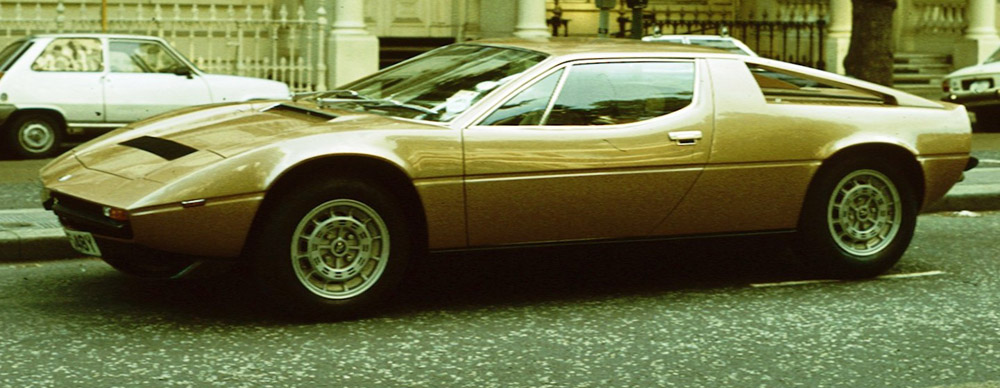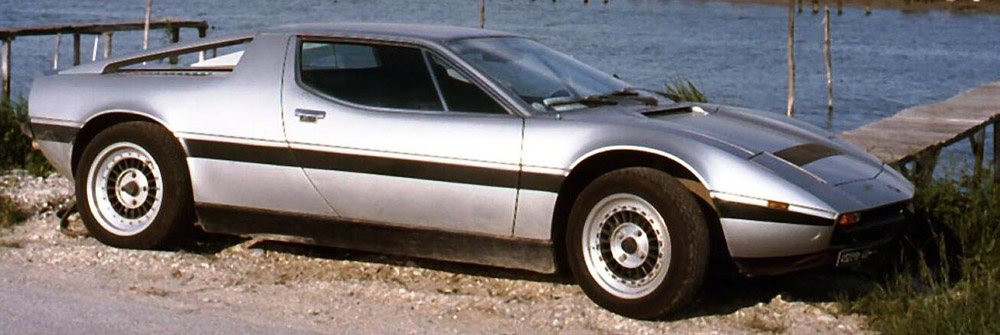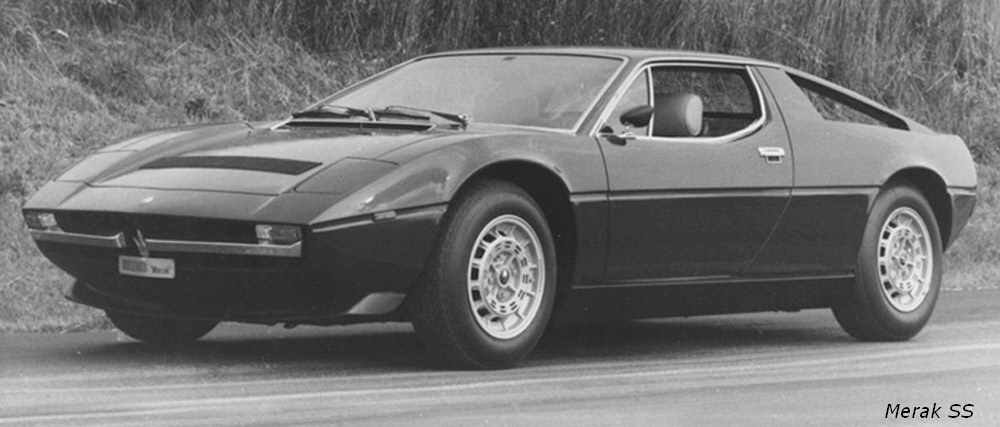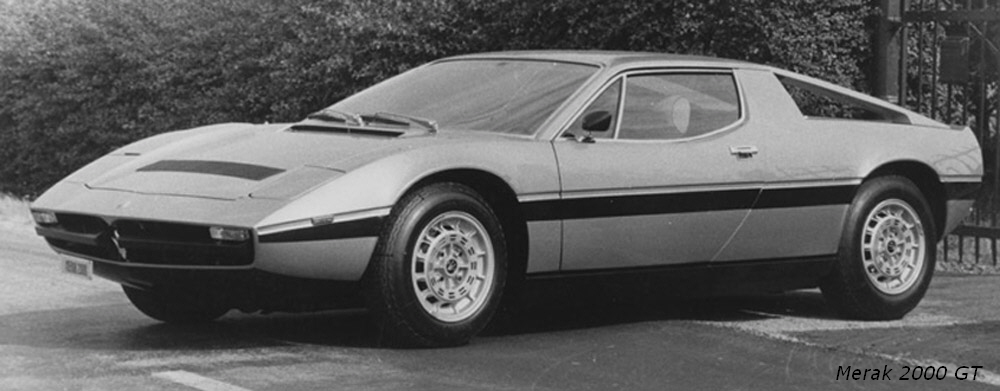
Maserati Merak (1972 to 1974)
The Maserati Merak was introduced at the 1972 Paris motor show, a year and a half after the Bora was unveiled. It shared the Bora’s mid-engine layout and some of its styling cues, but the big difference was under the rear hood: the Merak was powered by a 3 liter V6 which could trace its roots back to the Citroën SM-Maserati project. Maserati’s excellent reputation as a manufacturer had excited interest from Citroën, which had commissioned the design of the type C.114 2.7 liter V6 back in 1967 and the following year it took control of the company.
The engine was remarkable for its compactness, allowing a five-speed gearbox to be mounted ahead of it in the front-engined SM. It lent itself perfectly to being mounted amidships in the Merak, providing a more accessible alternative to the Bora. With cylinders bored out to 91.6 mm, the total displacement was 2,965 cc for this model and the output reached a more than respectable 190 hp at 6,000 rpm. Being 250 Kg lighter than the Bora, the Merak could achieve a top speed of 240 kph and handled superbly. Hydraulic brakes provided prodigious stopping power and were praised for their progressive response.
The name Merak did not refer to a wind, as was customary in this period, but rather to a star from the Great Bear constellation. The styling was derived from the general shape and proportions of the Bora, but the fastback shape was cut vertically right behind the seats and only ‘flying buttresses’ above the rear trunklid maintained a continuous silhouette. This innovative visual trick was once again the work of Giorgetto Giugiaro.
Maserati Merak SS (1975 to 1983)
In 1975 Maserati launched the Merak SS, an upgraded version of its V6 mid-engine sports car boasting a 30 hp increase over the earlier version. Tweaks included larger carburetors and a higher compression ratio, working together with a 50 Kg reduction in weight. A front grille between the pop-up headlights identified the car, while inside the cabin the Citroën-derived dashboard was replaced by a design drawn from the V8 Bora following production efficiencies.
Some minor chassis revisions further improved the car, which could now reach speeds in excess of 240 km/h. The SS remained the most powerful version of the Merak, although a development prototype (designed with the American market in mind) was tested with a turbo-charged 3 liter engine. The project never reached production.
Maserati Merak 2000 GT (1977 to 1983)
In the years following the first oil crisis demand for large engined sports cars fell drastically. While Maserati already had a more economical alternative to the Bora, in the V6 Merak, new company chairman Alejandro De Tomaso felt a version equipped with a smaller engine was called for to reinvigorate sales. Italian legislation imposed a 39% rate of VAT tax on cars with engines larger than 2 liters, and so the Merak 2000 GT was born. The same strategy would later give rise to the Biturbo range.
Revving up to 7,000 rpm, the V6 developed a healthy 170 hp and the level of performance remained convincing with a top speed of 220 km/h, and fuel consumption of 9.2 liters per 100 km. The expensive hydraulic braking system was discontinued on all Meraks from 1980. Externally the 2000 GT maintained the black grille seen on the SS between the headlights and added a thick black fascia below the waistline. Only two colors were available: light metallic blue and gold. Overall, the Merak range spanned three model variations and lasted 12 years. 1830 cars were sold of which 200 were 2 liter cars, exclusive to the Italian market.

Merak Technical Specifications
| Model | Merak |
| Maserati internal code | Tipo AM122 |
| Production start | 1972 |
| Number Produced | 630 |
| Ignition | single-plug, electronic ignition |
| Lubrication | single oil pump |
| Transmission | 5-speed + reverse synchromesh, rear wheel drive, single dry plate clutch, self-locking differential |
| Reduction | 1:4.85 |
| Gear ratios | I=2.92; II=1.94; III=1.32; IV=0.94; V=0.73; R=3.15 |
| Chassis | steel platform chassis |
| Front suspension | transversal deformable four-side with coil springs, telescopic shock absorbers and stabilizer bar |
| Rear suspension | coil springs, telescopic shock absorbers and stabilizer bar |
| Brakes | dual hydraulic high pressure circuit, second mechanical system on rear disks for parking |
| Brakes front | 280 mm ventilated disks |
| Brakes rear | 300 mm ventilated disks |
| Steering | rack and pinion with hydraulic shock absorber |
| Cooling system | front-mounted radiator |
| Length | 170.67 inches (4,335 mm) |
| Width | 69.60 inches (1,768 mm) |
| Height | 44.64 inches (1,134 mm) |
| Wheelbase | 102.36 inches (2,600 mm) |
| Front track | 58 inches (1,474 mm) |
| Rear track | 56.9 inches (1,447 mm) |
| Dry weight | 3,086 lbs (1,420 Kg) |
| Curb weight | 3,791 lbs (1,720 Kg) |
| Tires front | 185/70 VR 15 X |
| Tires rear | 205/70 VR 15 X |
| Wheels | light alloy, 7.50 x 15 |
| Top speed | 152 mph (245 kmh) |
| Bodywork | two-door, 2+2 mid-engine coupé |
| Fuel tank | 18.70 Imperial gallons (85 liters) |
| Range | 600 km (372.9 miles) |
| Standing kilometer | 0 to 1000 m. in 29 sec. |
| Production dates | 1972-1974 |
| Engine | 90° V6 |
| Bore and stroke | 91.6×75 mm |
| Total displacement | 2965.5 cc |
| Displacements (unitary) | 494.25 cc |
| Compression ratio | 8.75:1 |
| Maximum power | 190 bhp at 6,000 rpm |
| Maximum torque | 26 Kgm (189 lbs/ft) at 4,000 rpm |
| Timing gear | two valves per cylinder, twin overhead camshafts per cylinder bank |
| Fuel feed | aturally aspirated, three Weber 42 DCNF 31 and 32 carburetors |
| Fuel & lubricant | N 98/100 RM |

Merak SS Technical Specifications
| Model | Merak SS |
| Maserati internal code | Tipo AM122/A |
| Production start | 1975 |
| Number Produced | 1000 |
| Ignition | single-plug, electronic ignition |
| Lubrication | single oil pump |
| Transmission | 5-speed + reverse synchromesh, rear wheel drive, single dry plate clutch self-locking differential |
| Reduction | 1:4.37 |
| Gear ratios | I=2.92; II=1.94; III=1.32; IV=0.94; V=0.73; R=3.15 |
| Chassis | steel platform chassis |
| Front suspension | transversal deformable four-side with coil springs, telescopic shock absorbers and stabilizer bar |
| Rear suspension | coil springs, telescopic shock absorbers and stabilizer bar |
| Brakes | dual hydraulic high pressure circuit, second mechanical system on rear disks for parking |
| Brakes front | 280 mm ventilated disks |
| Brakes rear | 300 mm ventilated disks |
| Steering | rack and pinion with hydraulic shock absorber |
| Cooling system | front-mounted radiator |
| Length | 170.67 inches (4,335 mm) |
| Width | 69.60 inches (1,768 mm) |
| Height | 44.64 inches (1,134 mm) |
| Wheelbase | 102.36 inches (2,600 mm) |
| Front track | 58 inches (1,474 mm) |
| Rear track | 56.9 inches (1,447 mm) |
| Dry weight | 3,086 lbs (1,400 Kg) |
| Curb weight | 3,791 lbs (1,720 Kg) |
| Tires front | 195/70 VR 15 X |
| Tires rear | 215/7 0 VR 15 X |
| Wheels | light alloy, 7.50 x 15 |
| Top speed | 152 mph (245 km/h) |
| Bodywork | two-door, 2+2 mid-engine coupé |
| Fuel tank | 18.70 Imperial gallons (85 liters) |
| Production dates | 1975-1983 |
| Engine | 90° V6 |
| Bore and stroke | 91.6×75 mm |
| Total displacement | 2965.5 cc |
| Displacements (unitary) | 494.25 cc |
| Compression ratio | 9:1 |
| Maximum power | 220 bhp at 6,500 rpm |
| Maximum torque | 27.5 Kgm (196 lbs/ft) at 4,500 rpm |
| Timing gear | two valves per cylinder, twin overhead camshafts per cylinder bank |
| Fuel feed | naturally aspirated, three Weber 42 DCNF carburetors |
| Fuel & lubricant | N 98/100 RM |

Merak 2000 GT Technical Specifications
| Model | Merak 2000 GT |
| Maserati internal code | Tipo AM122/D |
| Production start | 1976 |
| Number Produced | 200 |
| Ignition | single-plug, electronic ignition |
| Lubrication | single oil pump |
| Transmission | 5-speed + reverse synchromesh, rear wheel drive, single dry plate clutch, self-locking differential |
| Reduction | 1:5.5 |
| Gear ratios | I=2.92; II=1.94; III=1.32; IV=0.97; V=0.76; R=3.15 |
| Chassis | steel platform chassis |
| Front suspension | double wishbones, coil springs, telescopic dampers |
| Rear suspension | double wishbones, coil springs, telescopic dampers |
| Brakes | discs, independent, dual circuit |
| Steering | rack and pinion |
| Cooling system | front-mounted radiator |
| Length | 170.67 inches (4,335 mm) |
| Width | 69.60 inches (1,768 mm) |
| Height | 44.64 inches (1,134 mm) |
| Wheelbase | 102.36 inches (2,600 mm) |
| Front track | 58 inches (1,474 mm) |
| Rear track | 56.9 inches (1,447 mm) |
| Dry weight | 3,152 lbs (1,430 Kg) |
| Curb weight | 3,791 lbs (1,720 Kg) |
| Tires front | 185/70 VR 15 XWX |
| Tires rear | 205/70 VR 15 |
| Wheels | light alloy, 7.50 x 15 |
| Top speed | 136.5 mph (220 km/h) |
| Bodywork | two-door, 2+2 mid-engine coupé |
| Fuel tank | 18.70 Imperial gallons (85 liters) |
| Production dates | 1977-1983 |
| Engine | 90° V6 |
| Bore and stroke | 80×66.3 mm |
| Total displacement | 1,999 cc |
| Displacements (unitary) | 333 cc |
| Compression ratio | 9:1 |
| Maximum power | 170 bhp at 7,000 rpm |
| Maximum torque | 19 Kgm (137.8 lbs/ft) at 4,000 rpm |
| Timing gear | two valves per cylinder, twin overhead camshafts per cylinder bank |
| Fuel feed | naturally aspirated, three Weber 42 DCNF carburetors |
| Fuel & lubricant | N 98/100 RM |

You must be logged in to post a comment.